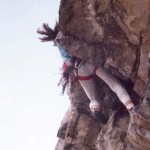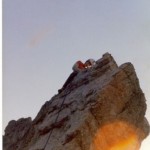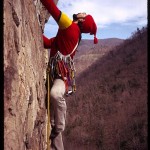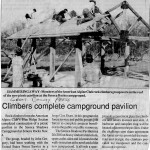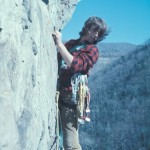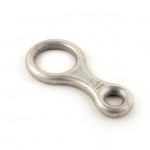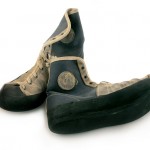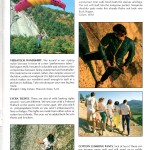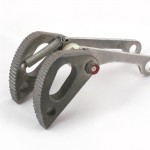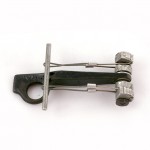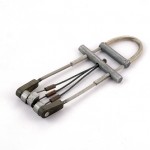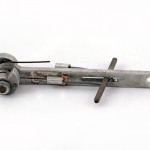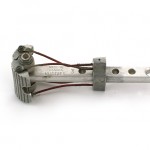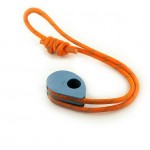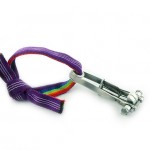By the mid-1970s, many of Seneca’s obvious first ascents had been made and the summit reached countless times. It was during these years that rock climbing made its official break from the summit-oriented sport of mountaineering. A new frontier would require pushing the limits of physical strength, gymnastic ability and mental fortitude to the extreme. Climbers perfected technique and pursued very difficult climbs with limited protection – without the goal of reaching the summit.
An important development in gear during this time was the introduction of smooth-soled climbing shoes such as EBs and PAs. These shoes dramatically improved footwork, allowing climbers to edge on tiny crystals and smear up featureless rock faces. In 1981, equipped with a dynamic nylon rope, rack of nuts, EBs and a lot of chutzpah, Cal Swoager put up the first 5.12, Satisfaction, and in 1983 put up the incredibly bold 12a R The Bell.
A pivotal moment in Seneca’s history was the placement of a controversial bolt on the route Sunshine (1975). This event epitomized the struggle between staunch supporters of a traditional ground-up climbing ethic, which accepts risk as part of the sport, and those who wanted to move toward sport climbing, which would open up a world of dangerously unprotectable climbs. In 1979 John Bercaw published the article “What Price for Glory,” lamenting the disappearance of risk and adventure in climbing through practices such as “hold chipping, aid-first, top-roping, or resting on protection” as well as the placement of bolts and fixed pegs. Bercaw goes on to explain: “Climbing was originally a sport where one increased one’s skill to meet the climb. Nowadays it’s a sport where one drags the climb down to meet one’s skill. The rock suffers and the sport suffers.”
The debates over bolting persists, but a strong unwritten code has emerged and Seneca remains one of the last strongholds of traditional climbing. While bolts continue to be drilled, they are placed sparingly, and with the ground-up ethic and preservation of the rock always in mind. Bolts placed on rappel are looked down upon, and it is generally accepted that whoever made the first ascent has the right to decide whether a route should be bolted. Hold chipping is obviously taboo, but resting on protection has become accepted – although if done excessively, climbers run the risk of being accused of hang dogging.
The Spring Loaded Camming device was patented by Ray Jardine in 1978. The introduction of this piece of gear was incredibly important in the larger climbing community. It allowed climbers to place gear faster and in previously unprotectable parallel cracks, which were very common in places like the Shawangunks. But the cam only modestly affected the climbing in Seneca, as it was already well-suited for the nut.
In the mid-1980s, hard climbers began to move away from Seneca, favoring the hard sandstone cliffs of the New River Gorge, in Fayetteville, West Virginia. Because of the New’s remote location, it had been largely unexplored by climbers until the early 1970s. This late start in route development left climbers with what seemed like an endless number of first ascents. While the quantity of climbs was a major draw, the quality of the rock made the New even more attractive. Major players in the international rock climbing community were calling the New some of the best technical climbing in the world.
While the establishment of the New did draw attention away from Seneca, the migration of climbers also helped to protect its environment and preserve its character, which overcrowding may have destroyed.
Catastrophic floods hit West Virginia in November 1985. Almost 50 people were killed and thousands of homes, businesses and roads were destroyed. Climbers living in the area saw the destruction firsthand, and several reported being trapped in their homes for days while the flood waters receded. The major effect the floods had on the climbing community was the destruction of the original camping area.
On October 22, 1987, after a major temperature fluctuation, the Gendarme collapsed into rubble. This dramatic disappearance of the Gendarme solidified its status as an icon of traditional climbing.
While route development was slowing, in 1988 John Bercaw put up Seneca’s first 5.13, Fine Young Cannibals. Thirteen years after this proud ascent, Seneca remains a place where climbers can continue to test their own limits on the classic routes of the past.
- Climber on West Pole roof
- Climber on the Gendarme, 1980
- Rich Goldstone on Ecstasy
- News article about the Seneca Pavilion
- Jim Nigro on Ecstasy. Photo Credit: Steve Williams
- Great Pacific Iron Works, 1980
- Clog Figure 8 Belay Device
- EBs, ca. mid 1970s
- Page from Wild Things Catalog, 1988
- Page from Wild Things Catalog, 1988
- Double Lobe Lowe Brothers Cam, ca. 1972
- Piton Cam
- Early TCU, ca. 1985
- Friend imitation cam
- Edelrid Single Lobe Cam ca. 1983
- Buddy
- Passive Cam CMI Prototype, ca. 1977
- Homemade Cam


